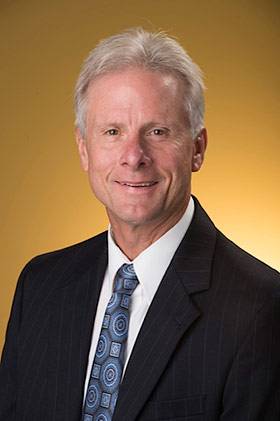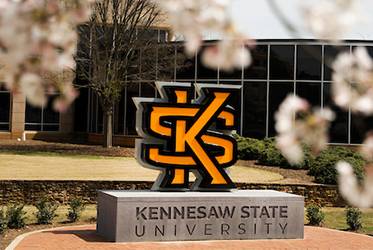

KENNESAW, GA | Feb 7, 2018

In 2016 James Tompkins was looking for a service opportunity, in particular to join or advise a Board of a charitable organization that needed help with its Corporate Governance. Professor Luc Noiset suggested he reach out to “Global Painting for Charity” (GPC). In April of that year he contacted founder Rony Delgarde and discovered a true example of what it means to be resourceful.
Rony, a native of Haiti, founded GPC in 2010. GPC is an entity that collects unwanted paint from businesses and people and redistributes the paint to those in need both domestically and internationally. As an example, the ripple effect of using unwanted paint for a school in Africa is astounding. The conversion from wasted to applied paint protects the environment, beautifies the school, increases the morale of the children, and has significant positive health impacts in the new dwelling. As shared on the GPC website, Rony tells the story of how in “March 2010, he visited Kenya and Uganda to help donate basic health supplies and nutrition kits to mothers in the refugee camps. He then found out there was a huge need for paint in the areas. Many of the existing family tents, homes, schools, churches, and orphanages that he saw were in such a poor state of renovation and beautification that they were not only uninhabitable but also poorly conducive to safety and health living standards. That's where he realized the need to beautify global housing projects in the region. Rony immediately started collecting paint after his Africa trip, hoping to collect 500 gallons of paint to renovate a school and orphanage in Africa within the same year. In fact, the paint that was collected in a single day was unbelievable. Over 6,000 gallons of paint were collected at the Gwinnett Braves in Buford Georgia. The spectacular response from the supporters, partners, volunteers and the media encouraged him to continue to collect paint and raise money to ship and distribute it." By 2016, GPC had distributed over 180,000 gallons of paint to those in need in the U.S. and 18 developing countries in the Caribbean, Central America, the Middle East and Africa. What is astounding is that Rony has accomplished this virtually single-handedly and in his “spare time” (since GPC does not have the funds to pay for even a single employee). Rony has personally organized volunteers to collect paint, has organized paint drives, has negotiated with country officials that receive the paint to pay for only the shipping, and all this on a shoestring budget funded by sparse and sporadic donations. Today, Rony continues to change the world one gallon of paint at a time.
While the accomplishments of GPC were truly resourceful (“to do much with little”), to develop partnerships with larger credible entities such as “Habitat for Humanity”, and to receive significant and more consistent donations from foundations and other established entities, it would be important for GPC to have a credible Board of Directors, and, as stated by the National Association of Corporate Directors, staffed with the “right people” who are engaged in the “right processes”. This was not the case in 2016 as judged by Habitat for
Humanity who considered GPC for a partnership agreement, and while they praised Rony’s story and accomplishments with GPC, the corporate governance of the entity needed work. When this need became apparent, Rony asked James to be on, and put in place, a Board and governance processes that would leverage the potential of GPC. Cliff Stanford, a partner at Alston & Byrd, who over the years had also provided help and shown great interest in GPC, agreed upon James’ recommendation to Chair the new Board.
Rony, Cliff and James met in November of 2016 to begin the thought process of staffing the GPC Board. In staffing a board, it is important to consider the “portfolio” of board qualifications in light of the strategic direction of the entity as well as the board committees’ composition and leadership. Rony had shared the existing strategic plan and James knew that the most immediate committee need would be an audit committee to provide oversight of processes to ensure the integrity of the financial statements. At this meeting they agreed on a target board size of 9 to fall more in line with a decision-making board, as opposed to a much larger board that is often seen at charitable organizations for fundraising purposes. James then shared a list of board qualifications he felt was important, and together, the three of them finalized this list. With a target list of Board qualifications established, James proposed a process for recruiting the desired board members and today, GPC is now a 7-member board and close to finishing the process of completing the board. As each new board member is recruited, James has done the “gap analysis” in tracking the inventory of board qualifications the GPC has, what the portfolio qualifications needs are, and the “gap” of qualifications/expertise still sought.
The GPC corporate governance goal was not just to staff the board with the “right” people”, but also to establish best practice processes in the board operations. To implement professional board operations, the first step would be for the directors to be on the same page regarding their duties and responsibilities. Consistent with best practices, James provided the GPC board with governance education that had the same degree of rigor and professionalism that he has given in other boardrooms for firms from small to large. In fulfilling the Board responsibilities, James stressed that every director has statutory fiduciary responsibilities to the entity (GPC) irrespective of whether the board member is paid or not (GPC directors are all volunteers). To put it simply, every GPC director must believe that they are acting in the best interest of GPC and to do so with due care. The responsibilities of a board are well summarized in corporate governance principles that were released by the Corporate Governance Center: “The board’s major areas of responsibility should be monitoring the CEO and other senior executives; overseeing the corporation’s strategy and processes for managing the enterprise, including succession planning; and monitoring the corporation’s risks and internal controls, including the ethical tone.”
Today, in addition to the audit committee, GPC also has an “External Relations” committee which puts board focus on fundraising, public relations and marketing. In matching best practices with board operations, each committee has developed its own charter that has been approved by the board. James also provided education to the Board on how a committee charter can serve as a valuable tool in promoting best practice processes for board operations.
A committee charter is essentially a job description for the committee that includes the committee purpose, duties and responsibilities, and protocols for how the committee is staffed and meetings conducted. The charter is used to plan the number of meetings needed to achieve the committee goals and establish an annual agenda, as a tool to annually self-evaluate the committee as they compare the actions of the committee against the duties outlined in the charter, and as a platform to ensure that committee members are on the same page regarding their committee job description. The board as a whole (as opposed to a committee) usually provides oversight and direction into the strategic planning and direction of the entity. In January 2018, consistent with best practices, the GPC Board had its first half-day “strategic planning retreat” to focus solely on GPC strategy. The Board is now well on its way to the level of professional governance sought by entities like Habitat for Humanity that require governance “credibility”. The Board meets at the Alston & Byrd headquarters quarterly and consistent with best practice standards approve minutes, receive committee reports, receive updates on GPC operations, discuss strategies and risks, and other business as needed.
James says he feels privileged and honored to be part of the GPC team and to have had the opportunity to hopefully add value to its governance processes. Evidence of the positive impact of the GPC concept and the incredible dedication and hard work by Rony is illustrated through GPC winning the “Energy Globe Award” in 2017. “With more than 178 participating countries and over 2,500 project submissions, the Energy Globe Award is today's most prestigious environmental prize worldwide. The Austrian Honorary Consul General, Mr. Ferdinand C. Seefried, hosted an exclusive ceremony to present the Energy Globe Award 2017 for the United States to Mr. Rony Delgarde, and the board of Global Paint for Charity.” A video that shares the GPC concept in more detail can be found at https://www.youtube.com/

Bringing Career Conversations Into the (Virtual) Classroom: Requiring One-On-One Office Hours in an Online Marketing Capstone for Student Success

How does Services Development Affect Manufacturing Export Competitiveness?

The Problem of Teaching Performance Evaluation and a Proposed Solution

Disruption at Regional Universities: Challenges and Opportunities.